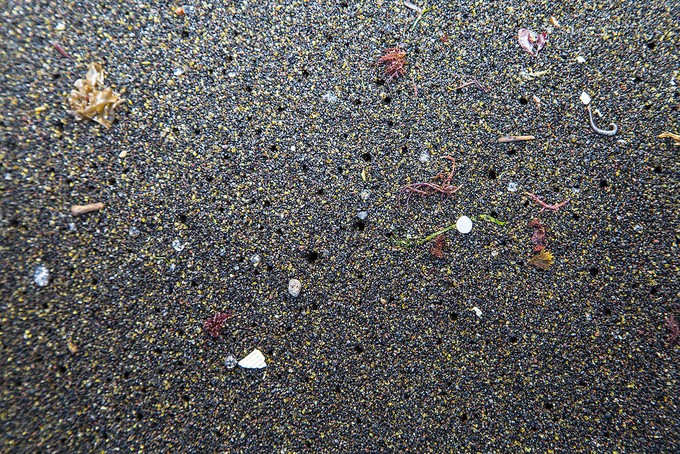Microplastics are a danger to our health. Here’s how to reduce our exposure to them
Some well-intentioned initiatives make the situation worse
Microplastics accumulating in the Azores. Photo by Wikipedia user Raceforwater (CC BY-SA 4.0 Deed)
About ten billion tons of plastic have been produced to date, of which around six billion tons have been discarded as waste. This is a severe threat to the environment, particularly oceans and lakes.
When plastics break down into particles smaller than five millimetres we call them microplastics. They are especially worrying.
Microplastics are an emerging threat to human health. They have been detected in organs in the human body and circulating in our bloodstreams. Studies have shown microplastics may deform red blood cells, inhibiting their ability to transport and transfer oxygen.
A study on mice exposed to microplastics found them in every tissue examined, and showed behavioural changes and heightened inflammation. While the exact effects on human health are not yet known, the risk is high enough that we should be very cautious about allowing them to pervade our atmosphere and food supply.
Microplastics have even been detected in high amounts in clouds, where they may affect rainfall patterns. They can also enter our food supply through rainfall.
A recent study of sediments in the Vaal river found an alarmingly high abundance of microplastics, which may enter the local food supply through crop irrigation. The sampling in this study was done in the region of the Vaal River Barrage, which is downstream of the Vaal Dam and fed by rivers that pass through heavily populated areas including Johannesburg.
Sampling at the Barrage gives direct insight into the rates at which we are producing microplastics in major population centres. And sampling at the Vaal Dam, which is the major drinking water supply for Gauteng, provides insight into the extent to which our drinking water is affected. Both these sampling points are needed as we track the levels of microplastics. Those levels are likely to rise dramatically; the microplastics we are seeing currently are only the tip of the iceberg, as there is a lag between the production of plastic, and it breaking down into microplastics.
Microplastic proliferation is not tied directly to accumulation of waste plastic. Examination of microplastics to ascertain their source is not an exact science, but it is reported that the main sources of microplastic pollution, at least for now, are car tyres and textiles and the pollution arises, not at the end-of-life when these are discarded as waste, but during their day-to-day use.
In other words, even if we solve the problem of waste plastic, we would still face the problem of microplastics that are emitted during the normal lifespan of products made of plastic.
There are, fortunately, some concrete steps that people can take to reduce personal exposure to microplastics. While microplastics are clearly able to travel throughout the atmosphere, their levels are concentrated around the sources releasing them. Microplastic concentrations are higher in indoor than outdoor air; old-fashioned fresh air and good ventilation are beneficial. So too is regularly wiping down surfaces, as they accumulate microplastic dust. Household air filters may also reduce microplastic concentrations.
Perhaps the most useful thing we as individuals can do is to have a different relationship with clothing. Synthetic fabrics are a prolific source of microplastics. These are released in our immediate surroundings, making our exposure to them disproportionately high.
Most microplastic release from textiles occurs within the first few washes after purchase, so purchasing long-lasting clothing rather than frequently replacing items of clothing can reduce your exposure, as can choosing natural fabrics such as cotton, where possible.
The other major source of microplastics is car tyres, which shed microplastics constantly as they wear down.
There are also activities which may seem environmentally-friendly but probably exacerbate microplastics pollution.
It is increasingly common to convert waste plastic into useable products from shoes and clothing to integration of waste plastic into road surfaces.
At first glance, this appears to be an environmental win-win. But recycled products tend to be more susceptible to the abrasion that causes microplastic release. Moreover, waste and recycled plastics tend to wear out more quickly and require replacement more frequently.
This is perhaps most harmful in the case of clothing made of waste or recycled plastic; the release of microplastics in early washes will be more severe because of the weaker polymer. This is particularly worth highlighting because recent research has shown that tumble-drying of synthetic textiles results in prolific microplastic release, much of which may be discharged into the indoor environment and breathed in or otherwise consumed.
Currently we have no practical way to remove microplastics from the environment; the particles are simply too small and widely dispersed. This means that we must exercise extreme caution to minimise emissions and our personal exposure to them.
© 2023 GroundUp. This article is licensed under a Creative Commons Attribution-NoDerivatives 4.0 International License.
You may republish this article, so long as you credit the authors and GroundUp, and do not change the text. Please include a link back to the original article.
We put an invisible pixel in the article so that we can count traffic to republishers. All analytics tools are solely on our servers. We do not give our logs to any third party. Logs are deleted after two weeks. We do not use any IP address identifying information except to count regional traffic. We are solely interested in counting hits, not tracking users. If you republish, please do not delete the invisible pixel.



